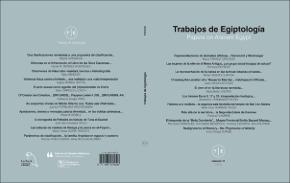Ofrendas en el Inframundo: el Libro de las Doce Cavernas en el Osireion de Abidos
Author
Méndez Rodríguez, Daniel M.Date
2020Abstract
El Libro de las Doce Cavernas consiste en una letanía de dioses que habitaban estas regiones míticas del Más Allá. La versatilidad de su carácter cosmográfico permitió su uso y adaptación a diferentes contextos. Fue utilizada en determinadas ceremonias litúrgicas en templos y también en una vertiente funeraria asociada al ajuar de algunos difuntos, con vistas a ayudarles en su viaje a través de las cavernas de la Duat. La versión de la composición inscrita en la cámara meridional del Osireion de Abidos es, sin duda, el ejemplar más completo conservado hasta el momento y data del reinado de Merneptah (ca. 1213-1203 a. e.). El objetivo de este artículo es presentar las principales características de la obra. Se destacarán sus peculiaridades específicas así como su adaptación, tanto textual como iconográfica, a un uso cultual; y por otro, en la ausencia de diferenciación en algunos aspectos respecto a las versiones de carácter funerario. Asimismo, el libro se analizará en el contexto arquitectónico de la sala y, de forma más general, en el programa iconográfico del complejo subterráneo osiriano. Por último, se detallará la relación con otras fuentes a lo largo de la historia de la transmisión de la obra. The Book of the Twelve Caverns consists of a litany of deities who inhabited these mythical regions of the Beyond. The versatility of its cosmographic nature enabled its use and adaptation to different contexts. It was used in certain liturgical ceremonies in temples and also in a funerary sphere related to the burial equipment of certain deceased individuals in order to help them in their journey through the caverns of the Duat. The version of the composition inscribed in the south chamber of the Osireion in Abydos is, beyond any doubt, the most completed copy hitherto preserved. It can be dated to the reign of Merenptah
(c. 1213-1203 BC). The aim of this paper is to present the main features of this example of the book. Its specific features will be highlighted, as well as its textual and iconographic adaptation to the cultic sphere. The absence of differentiation in some aspects to the funerary versions of the book will also be underlined. The composition will be analysed in the architectonical context of the chamber and, at a more general level, in the iconographic programme of the Osirian underground complex. Finally, the relationship with some other sources throughout the history of the book’s transmission will be detailed.





